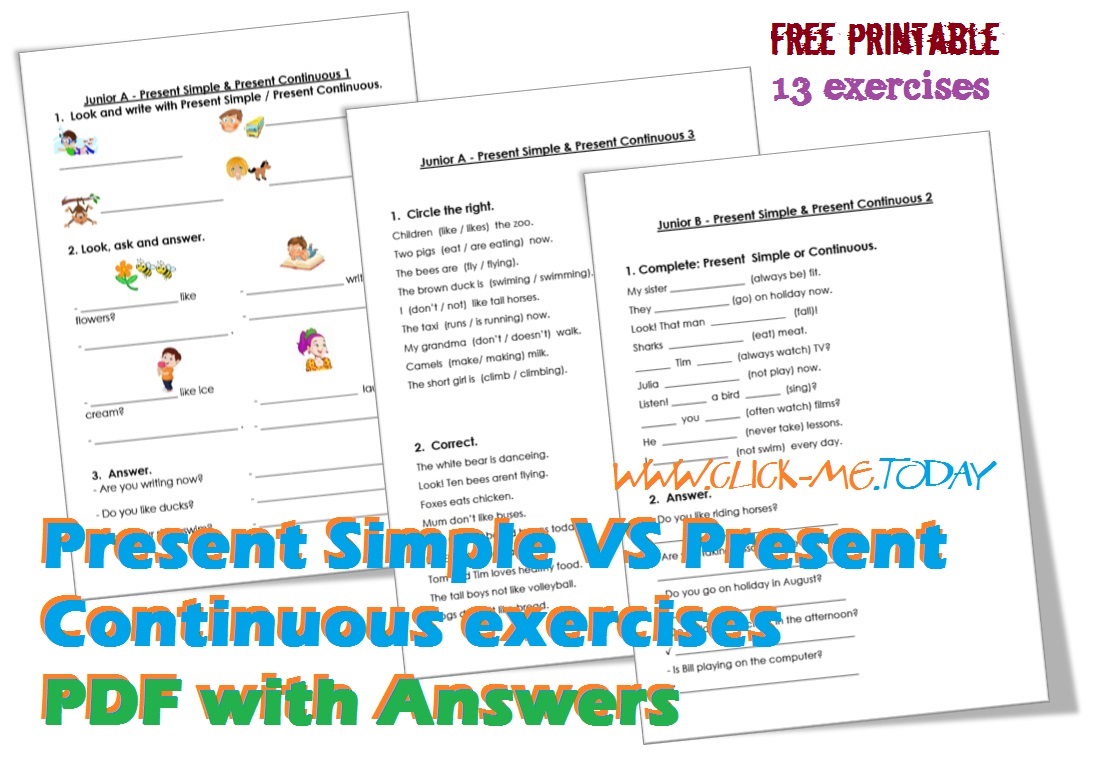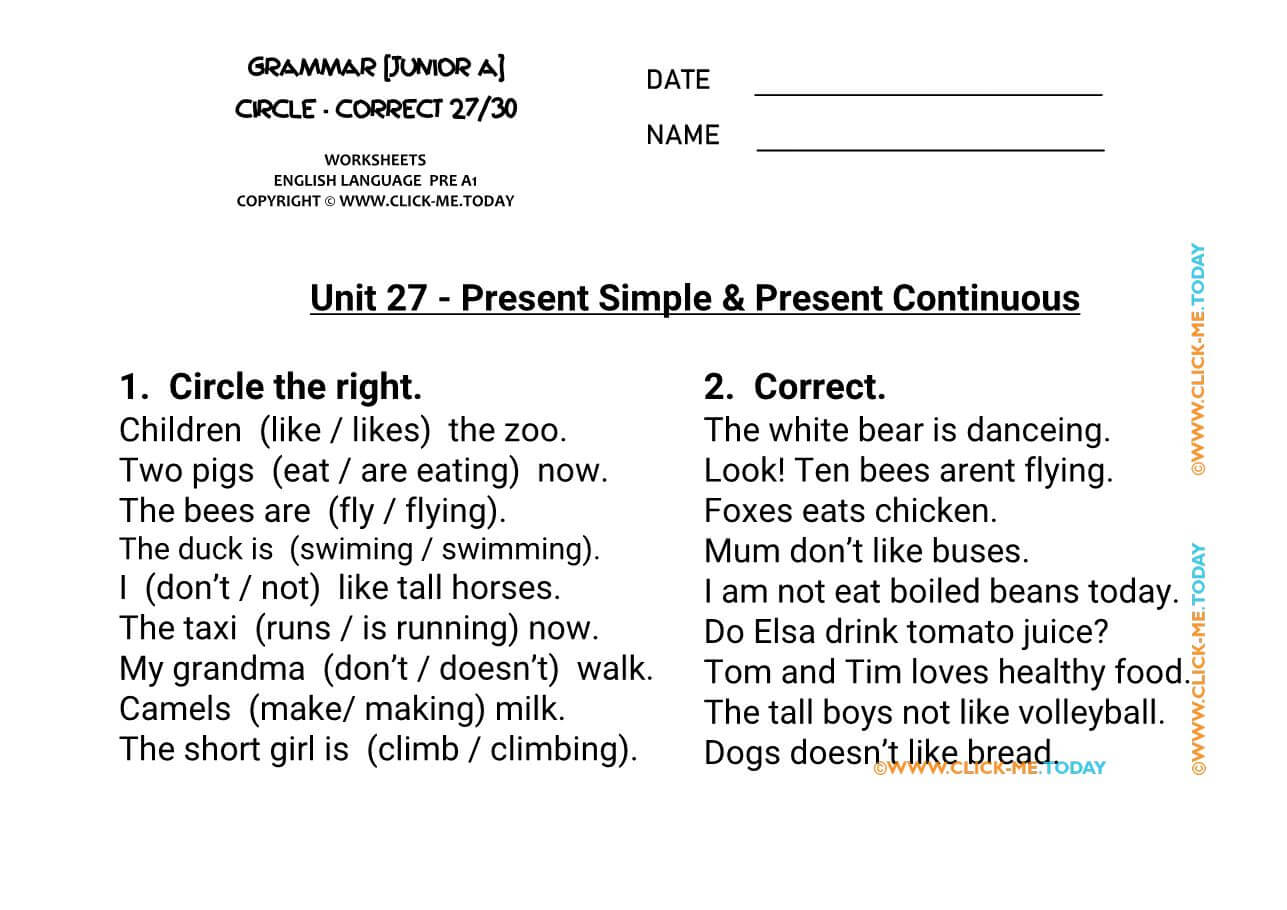Present Simple Versus Present Continuous Exercises

Capita spesso di sentirsi persi tra il Present Simple e il Present Continuous. Non siete soli! Molti studenti di inglese, come voi, si scontrano con questa difficoltà. Può sembrare una differenza sottile, quasi impercettibile, ma comprenderla a fondo è cruciale per comunicare in modo efficace e naturale. Immaginate di voler descrivere la vostra routine mattutina a un amico: userete il Present Simple o il Present Continuous? Direste "I am drinking coffee every morning" o "I drink coffee every morning"? La scelta giusta fa la differenza tra una frase grammaticalmente corretta e una che suona un po'… strana. Vediamo insieme come districarci in questa giungla grammaticale.
Quando Usare il Present Simple
Il Present Simple è il tempo verbale che usiamo per descrivere azioni abituali, verità generali, fatti permanenti, orari e programmi. Pensate a quelle cose che fate regolarmente, che sono sempre vere, o che sono pianificate in anticipo.
Abitudini e Routine
Le abitudini sono le nostre azioni quotidiane. Ecco alcuni esempi:
- I wake up at 7 am every day. (Mi sveglio alle 7 ogni giorno.)
- She drinks tea in the morning. (Lei beve tè la mattina.)
- They go to the gym after work. (Loro vanno in palestra dopo il lavoro.)
Verità Generali e Fatti Permanenti
Le verità generali sono cose che sono vere per tutti, sempre. I fatti permanenti sono cose che rimangono vere per un lungo periodo di tempo.
- The sun rises in the east. (Il sole sorge a est.)
- Water boils at 100 degrees Celsius. (L'acqua bolle a 100 gradi Celsius.)
- He lives in Rome. (Lui vive a Roma.)
Orari e Programmi
Usiamo il Present Simple per parlare di orari di treni, aerei, film, ecc. che sono fissi.
- The train leaves at 9:00 am. (Il treno parte alle 9:00.)
- The movie starts at 8:30 pm. (Il film inizia alle 8:30.)
Quando Usare il Present Continuous
Il Present Continuous, invece, si usa per descrivere azioni che stanno accadendo ora, azioni temporanee, piani per il futuro, e situazioni in cambiamento. Immaginate una fotografia di un momento preciso: ecco, quello è il Present Continuous in azione!
Azioni che Stanno Accadendo Ora
Queste sono le azioni che stiamo compiendo proprio in questo istante.
- I am writing this article. (Sto scrivendo questo articolo.)
- She is listening to music. (Lei sta ascoltando musica.)
- They are playing football in the park. (Loro stanno giocando a calcio nel parco.)
Azioni Temporanee
Queste sono azioni che stiamo facendo, ma che non sono parte della nostra routine abituale.
- I am staying at a hotel this week. (Sto alloggiando in un hotel questa settimana.) – Normalmente non alloggio in hotel.
- She is working on a new project. (Lei sta lavorando a un nuovo progetto.) – Questo non è il suo lavoro quotidiano.
Piani per il Futuro
Possiamo usare il Present Continuous per parlare di piani che abbiamo fatto per il futuro, soprattutto se sono stati organizzati.
- I am meeting my friend tomorrow. (Incontrerò il mio amico domani.)
- She is traveling to Italy next month. (Lei viaggerà in Italia il mese prossimo.)
Situazioni in Cambiamento
Usiamo il Present Continuous per descrivere situazioni che stanno evolvendo o cambiando.
- The climate is changing rapidly. (Il clima sta cambiando rapidamente.)
- The population is growing. (La popolazione sta crescendo.)
La Difficoltà dei Verbi di Stato
Un aspetto che spesso crea confusione sono i verbi di stato (o stative verbs). Questi verbi descrivono stati, sentimenti, opinioni, o possesso, e normalmente non si usano al Present Continuous. Alcuni esempi includono: like, love, hate, know, believe, understand, remember, want, need, own, have, see, hear, smell, taste.
Quindi, invece di dire "I am wanting a pizza," diremmo "I want a pizza." Invece di "She is knowing the answer," diremmo "She knows the answer."
Tuttavia, alcuni verbi di stato possono essere usati al Present Continuous con un significato diverso. Ad esempio:
- I see what you mean. (Capisco cosa intendi.) – Present Simple (stato mentale)
- I am seeing a doctor tomorrow. (Domani vado dal dottore.) – Present Continuous (appuntamento fissato)
Controargomentazioni e Approfondimenti
Alcuni potrebbero sostenere che la regola dei verbi di stato è troppo rigida e che l'uso del Present Continuous con questi verbi è in aumento, soprattutto nella lingua parlata. Questo è in parte vero, e la lingua è in continua evoluzione. Tuttavia, per una comunicazione chiara e corretta, è meglio attenersi alla regola, specialmente quando si impara la lingua. Comprendere la ragione dietro la regola ci aiuta a navigare queste eccezioni con maggiore consapevolezza.
Esercizi Pratici
Ecco alcuni esercizi per mettere alla prova la vostra comprensione:
- Completa le seguenti frasi usando il Present Simple o il Present Continuous:
- I ________ (drink) coffee every morning.
- She ________ (work) on a new project this month.
- They ________ (play) football in the park now.
- The sun ________ (rise) in the east.
- He ________ (live) in Rome.
- Correggi le seguenti frasi se necessario:
- I am wanting a pizza.
- She is knowing the answer.
- He is having a car.
- Scrivi cinque frasi su di te usando il Present Simple e cinque frasi usando il Present Continuous.
Soluzioni degli esercizi:
-
- I drink coffee every morning.
- She is working on a new project this month.
- They are playing football in the park now.
- The sun rises in the east.
- He lives in Rome.
-
- I want a pizza.
- She knows the answer.
- He has a car.
- (Esempi)
- Present Simple: I eat breakfast at 8 am. I work as a teacher. I love reading books. I go to bed at 11 pm. I speak Italian.
- Present Continuous: I am learning English. I am listening to music right now. I am planning a trip to Spain. I am working on my computer. I am eating dinner.
Strategie per Ricordare le Differenze
Ecco alcune strategie per aiutarvi a memorizzare le differenze tra il Present Simple e il Present Continuous:
- Visualizzazione: Immaginate il Present Simple come una linea retta che rappresenta la routine, e il Present Continuous come un punto che rappresenta un momento specifico.
- Associazione: Associate il Present Simple con "sempre" o "abitualmente," e il Present Continuous con "ora" o "in questo momento."
- Pratica costante: Fate esercizi regolarmente per rafforzare la vostra comprensione.
- Immersione linguistica: Ascoltate e leggete l'inglese il più possibile per osservare come vengono usati questi tempi verbali in contesti reali.
In Conclusione
Spero che questo articolo vi abbia aiutato a chiarire le differenze tra il Present Simple e il Present Continuous. Ricordate, la pratica rende perfetti! Continuate a esercitarvi e non abbiate paura di fare errori. Gli errori sono un'opportunità per imparare e crescere. Ora, ripensando alle frasi iniziali, sapreste dire perché "I drink coffee every morning" è corretto e "I am drinking coffee every morning" (in questo contesto) no? Siete pronti a mettere in pratica le vostre nuove conoscenze nella vostra prossima conversazione in inglese?








